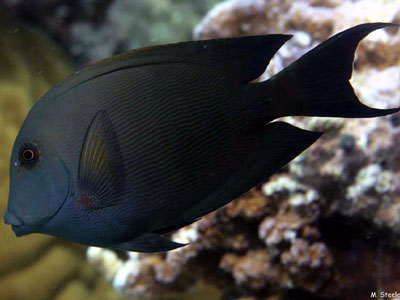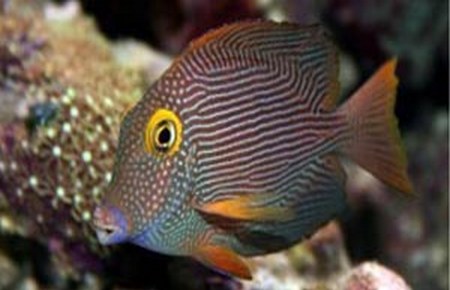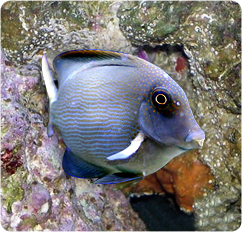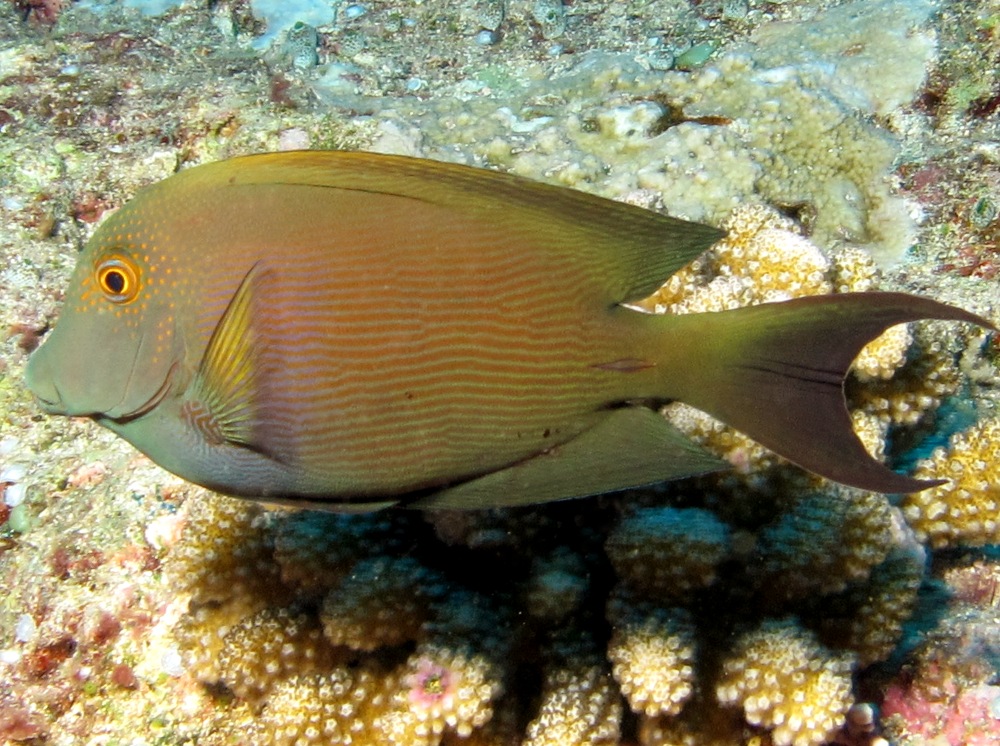
Ctenochaetus striatus
FAMILY
Acanthuridae
TAXONOMY
Ctenochaetus striatus Quoy and Gaimard, 1825, Guam, Mariana
Islands.
OTHER COMMON NAMES
German: Brauner Borstenzahndoktor; Japanese: Sazanamihagi.
PHYSICAL CHARACTERISTICS
The body is compressed and disc-like, with a venomous,
scalpel-like caudal spine on each side of the caudal peduncle.
The caudal fin is lunate. There are eight spines and 27–31 soft
rays in the dorsal fin, three spines and 24–28 soft rays in the
anal fin, and 17 (sometimes 16) soft rays in the pectoral fin.
Adult coloration varies from dark gray to orangish brown. Can
change color temporarily from dark brown to light tan.
Melanistic, albinistic, and xanthic color patterns have been reported
as well. There are several fine pale blue lines along the
flank. Fine orange spots appear on the upper head and back to
the anterior base of the dorsal fin. Both the dorsal and anal
fins have narrow dark brown and pale blue bands, running longitudinally
in alternation. Juveniles and subadults are especially
colorful, with a small black spot located at the posterior base of
the dorsal fin. Grows to 10.2 in (26 cm) in length.
DISTRIBUTION
Indo-West Pacific, from the Red Sea south to East Africa, east
to Pitcairn Island and French Polynesia (absent from the Marquesas
Islands), north to southern Japan, and south to the
Great Barrier Reef and New Caledonia.
HABITAT
Found on coral, rock, pavement, and rubble of exposed reefs,
reef flats, and lagoons in tropical waters. Depth range from 3.3
to 98 ft (1–30 m).
BEHAVIOR
Found singly but also in small and very large aggregations.
Also participates in mixed-species aggregations with other surgeonfishes
and parrotfishes, among others.
FEEDING ECOLOGY AND DIET
Herbivorous. Feeds upon benthic algae, blue-green algae, and
diatoms. Reported to cause ciguatera poisoning because of their
diet. Ciguatera poisoning is caused by the cumulative deposition
of a class of polyether toxins within the tissues of fishes. The
toxins are produced by certain microscopic dinoflagellate organisms
of the genus Gambierdiscus, which are transmitted by the
food chain, increasing in intensity by a factor of ten in each successive
level within the chain. The striped bristletooth ingests
these organisms while feeding upon algae. If a contaminated fish
is consumed by man, the concentrated poison contained within
its tissues causes neurological damage that can be fatal.
REPRODUCTIVE BIOLOGY
Migrates to outer channels or exposed reefs to spawn in aggregations
on an outgoing tide. Eggs and larvae are pelagic.
CONSERVATION STATUS
Not listed by the IUCN.
SIGNIFICANCE TO HUMANS
Taken for subsistence and artisanal food fisheries but may cause
ciguatera poisoning at some localities. Also collected infrequently
for the aquarium trade but often they do not do very
well in captivity; juveniles are more highly prized than adults.
Other popular Animals
Photo Gallery of - Striped bristletooth





 Animalia Life
Animalia Life